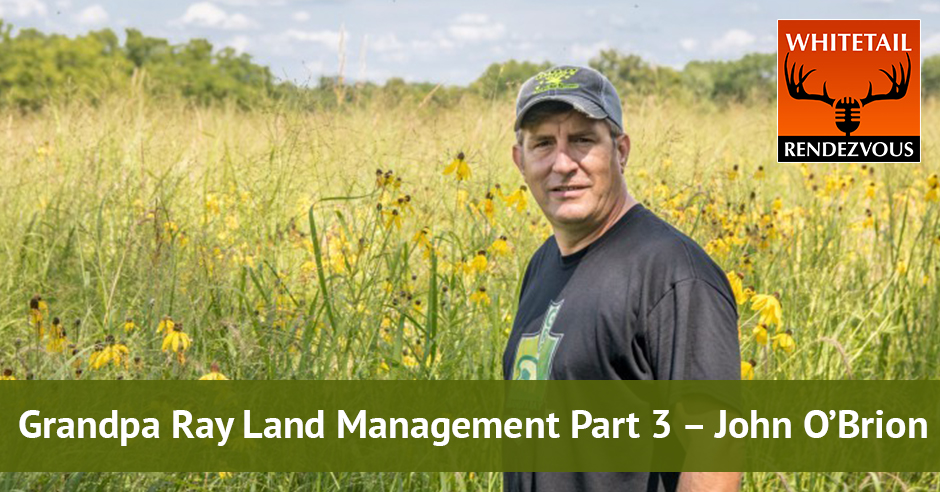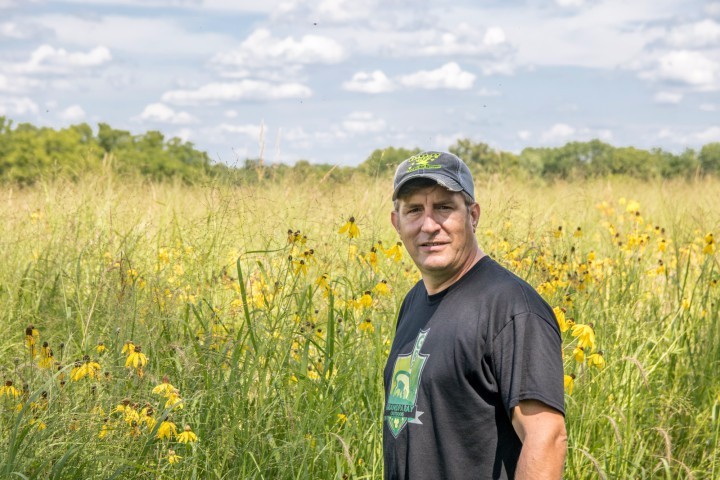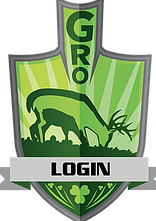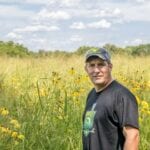
Listen to the podcast here:
Grandpa Ray Land Management Part 3 – John O’Brion
This is the third and final segment with Land Management with Grandpa Ray Outdoors and Mr. John O’Brion. We’re going to talk about plan. Finally, all this work has gone in and I thought about it. Now you’re going to get some digital document, a paper document or a combination of those things. You can look at this from year one to however long your plan runs. John, welcome back to the show. Let’s talk about the plan from Grandpa Ray Outdoors.
If I have somebody where I’m stepping on a property, hopefully, they’ve had soil samples taken ahead of time, but if they haven’t, that’s one thing that we’ve done at times. I’ve helped people take soil samples as we’re walking around if we’re in the property because without a soil sample, I’m just guessing. We’re rolling the dice. It’s hard to formulate a solid plan. That’s essential. When I’m on a property, we’ll walk around and if there are existing plots, everybody’s probably got a name for each plot and if they don’t, well help create a name. I guess in some cases people are like, I don’t care. I call it plot one, two, three, five, eight,” or whatever. What we’ll do then is I’ll have a plan that we’ll put on hardcopy and you’ll have the name and the acres of each plot.
It’ll have what seed mix that we’re going to recommend, when to plant that seed mix, how much of that seed mixed to plant, what fertilizer to use for that seed mix, how much of that fertilizer to use and when. Then again, we also will have some little notes on there saying you have to put in your mix every 30 to 45 days. Maybe if a guy’s got certain weed issues, I’ll give a recommendation saying, “Use 9-4-9 Plant Foods.” When I do a plan, it’d be for the current year. Also, when we’re walking around on these properties, we’ll also bring up this part of the plan that the following year we’ll have another plan. What we’re planning this year is setting yourself up versus doing something the following year on that bit of land.
That’s one thing that we do discuss. With technology, whether you’re using Huntstand or onX Maps, we have the ability to use the aerial imagery to create a measurement tool and the shading and the layout where people can look on an email, a picture and be like, “This is plot one. It’s 0.5 acres. Here’s how it is laid out.” That also is beneficial not just with me short-term and long-term but also for the land manager because in some of these plots we might have multiple mixes planted. With any plot, you’ll probably want to be considering a scrape line, maybe screening to help get you in your stand or to make these plots a little less able to be viewed from a distance by a buck. Try to also little doorways and travel quarters to make your property more of a highway.
Make a plan that is easily understood by the average person. It doesn't need to be a Bible. Share on XThat is part of the plan and the thinking there. Depending on how many food plots, maybe it’s a page, maybe it’s two or three pages of hard copy where we have all that essential information. Let’s say we’re planting a clover mix. I’ll have a recommendation on what fertilizer that plant needs. It also might have, “We want to winterize that plot.” We’ll tell them that in September, you’re going to come back with potassium and add another hundred pounds. We put a lot of information on the plan. It’s easy enough to look at because we could make this rocket science and to the average person, they just want to look at it, be able to understand it easily and apply it. It doesn’t need to be a Bible. It doesn’t need to be a book. We’re creating a basic plan that everybody understands.
How long does your typical plan lasts per person? We talked about it in the other segments, what if the farmers growing corn one year and then soybeans the next year and then alfalfa on the other year. That’s years of different food sources that provide different nutrition to deer and guess what? They know what’s on the table.
For me, when it comes to crop rotation, it is essential for long-term sustainability. It could be a different amount of years, but I like at least a three-year rotation. Case on point, because we’re talking right now about habitat. Habitat could also be a cornfield. A habitat could be a deer and birds mix. Habitat could be a permanent screening. Habitat could be an annual screening mix. Again, that also can be a part of the long-term plan. You could have a strip. Maybe in year one, it’s soybeans. On year two, it is corn. On year three, it’s a soil builder or a warm-season annual mix that you can till down with organic matter and then come back in again in year four with soybeans and repeat the process. That’s why when we get started, you got sand ground, loam ground and clay. Those all come into play as far as what we plant, where to plant when to plant and then how many year rotation.
When people call you up, we talked about the input sheet or your questionnaires, typically to walk my ground and you’re not selling me anything, being a consultant, what can they expect from that type of engagement?

When people get ahold of me and I get out on their property, every situation is different. I could spend two hours or I could be spending a day there if that’s what needs to be done. What I tend to do is walk the property, communicate with the individual, take a bunch of notes, do measurements where it need be, take soil samples where it need be. As I leave that property, my brain is working and I’m maybe coming up with some other alternatives. Maybe we talked about some things that there’s out there on the field, but then as I started thinking about this long-term plan, maybe there’s a couple of little tweaks. Maybe I need to look at this a little different. Get in front of a computer, maybe measure out some of these fields.
We have a rough idea of what we want to do this year, but then when I try to think about a three-year potential rotation, maybe we need to change a couple of plots so it fits your rotation. Let’s say if a guy’s got eight food plots. I never want to plant too much one of the mix, not just because of the biodiversity but also it’s harder to maintain a good rotation when you do not have enough diversity. With that in mind, here’s what I like to talk to people as far as goals. We always want to fixate nitrogen where possible and to any bit of land every year, we want to naturally suppress weeds and we want to build organic matters. A lot of properties out there low in organic matter and very few people have enough organic matter.
Again, we want to minimize inputs. Who wants to spend a lot of money on fertilizers? Not me. When we lay out a plan and remember, I brought up nitrogen fixation. I also talk to people about, “You can suppress nutrients by using radishes and some bulbs.” They uptake nutrients. When they reroute that ground in February or March, they’re re-releasing nutrients. With erosion and rain, nutrients can get eroded and out of the roots. There are also other factors that come into play that most property managers don’t think about. This is economics. This is long-term sustainability. These are things that I consider my job. That’s my consideration why I work out a plan the way I do besides, “This would be a great mix to plant in this area because the deer will come here. They’ll love it. You’ll shoot a deer.”
That’s short-sighted and short-term thinking.” We don’t want to ever mine soil. We want to maximize any bit of fertilizer that we put down. We want to have as much growth of whatever we decide to plant as we can and again as part of that equation, we don’t want the deer to walk super far to get to these areas. What does that mean? We need to layout bedding areas, whether it be stumped cutting, hedge cutting, perennial warm-season native grasses or annual warm-season cover areas. As I said, they can be part of the rotation. They could complement the rotation, but as you mentioned in the past and so many people talk about, what do we need? Food, bedding, cover and water. We need it close. We need it accessible. We need it to be quality. It’s all part of my thinking.
Build organic matter in your properties so you won’t have to spend a lot of money on fertilizers. Share on XTypically, when somebody does call you, when do you decide you’re going to go on the ground, do they give you a deposit or do you just say, “I’ll come by and look?” You can’t be going all over the country. You talked about going off to PA, so how does that work? People don’t know. They say, “I’ll call up the seed guy. He’ll come to walk my thing, sell me some seed and fertilizer and then I’m on my own.” It’s confusing to me.
It depends if you’re Bruce Hutcheon or a good buddy of yours or somebody that’s been a long-term customer that you trust, I’m not so worried. If it’s somebody I don’t know from Adam, I do like to have a deposit. Moving forward, we’re going to be doing things a little different with charging. That’s something that as I’m getting to have more demand throughout the United States, there’s a lot of demand on my time. Again, we’re going to have to do things to be a little bit different to be fair, not to the other properties that I’m trying to schedule on, but also to be fair to myself. I need to be more of a planner for the process to be cost-effective for our customers as I try to schedule multiple visits in certain areas.
Bruce, I know you got a property over there in Southwest Wisconsin. If you’re like, “John, I need to get you out there.” I also know that there’s maybe another guy or two that have also wanted me to get on that property and in that area, we try to schedule it the same day so we can share the mileage a month, each of the two or three a property owners to be more efficient, cost-effective for each you guys. It’s also easier for me. I don’t have to go back and forth as many times. I’m blessed that I got a very busy schedule and it’s great to plan. Everybody should plan more. It makes life less stressful.
 It does. I’ll throw this out. If you haven’t considered somebody to come and put eyes on your ground, on the land management, this is the year to do it. This is the month to do it. You need to get cracking.
It does. I’ll throw this out. If you haven’t considered somebody to come and put eyes on your ground, on the land management, this is the year to do it. This is the month to do it. You need to get cracking.
For me, when’s a great time to have John on a property? I like to say any time. I’ve had some interesting cases where we had a problem because when you schedule, I’ve been on a property where it was twenty below zero. We did a lot of good things. It worked. We had another case, we go out to South Central Wisconsin, a little farther North Central. I was expecting no snow on the ground. We fly around 500 acres, have a great time, do a lot of good and get out of there. Within a hundred yards of the cabin we got stuck on twelve inches of snow on the ground. I had to walk the property with a guy and every step, we are sinking eight inches deep. Again, it’s a different perspective if I’d been there a month later in July.
Ideally, I’d like to have my foot on the ground where I can see the soil, see the soil compaction and see if there are any weed challenges. Again, I get on the property any time. Case in point, maybe I can’t get onto Bruce’s property until June 1st. What’s the advantage of being on the property on June 1st? If you have existing growing clovers on June 1st, I could see the problem areas on your property. Maybe there are some plant health issues. Maybe there are some poor growth issues. Maybe it gets very little growth in one area. At that point in time, I’ve become a crop scout. I get a feel for your soil types based on what’s growing versus I’m all through in February. The biggest advantage of February is we don’t have all the leaves out there.
We can see the travel areas maybe a little bit better before the spring green up. Maybe we can see where the deer are bedding a little better that time of year versus in June. Also, in some areas in Wisconsin, I’m not going to lie, the mosquitoes are probably killing us. We maybe are not quite spending as much time dialing things in because we’re like, “We got to get the heck out of here. We’re getting eaten alive.” It could be August. It could be in September. There’s always good that could be done at any time a year depending on where you live. You’re going to get whole different answers and different types of scouting. Again, the end result is you’re still getting valuable information.
It’s interesting. I’m sitting here and snow’s blowing through and I’m thinking about a great time to scout for deer. I used to love the January, February time because the trails are there. They were going from bedding to food. There are no secrets to that. In your plan, I broke it. I’d like to think you break it down on the quarters and it encompasses everything. What am I going to scout? What areas am I going to start shed hunting? Where have I found sheds before? It just doesn’t stop. What are your thoughts about that?
Everybody should plan more. It makes life less stressful. Share on XWhen to scout and how to scout. That’s the great thing with February and March, you can accomplish two things at one time. You can be shed hunting, but also we could be seeing areas where maybe we need to move our stand to a different tree because maybe their travel pattern’s moved. Maybe you’re responsible for that travel pattern move, hopefully not. When I’m out scouting some of these properties for people, if I’m walking around and all of a sudden that deer stand sticks out like a sore thumb, maybe it’s sticking out for the deer. Then again, I’m walking around, I’m like, “Where’s your stand?” “It’s right there,” and they have to look to find it, then I know that you did a great job because if I’m not seeing it, the deer probably are not seeing you in that area too. When are you going to want to move these stands? Probably a good time to be getting it done is before it gets to go beyond April, maybe May because what we want to do is not go into these.
This is probably the only time of year we want to go into those sanctuaries, core areas. We can scout it. Let’s not go back in there again. Let’s say, “We are committed. We’re not going in these areas on this date.” That’s the one advantage of getting out there in February through April. It’s like, “Let’s move their stand. Let’s go. Let’s look for sheds.” Maybe there are some trail cameras because of technology. Maybe you got the cellular camera where every time a deer walks past it takes a picture, it sends it to your phone and so you wouldn’t have to walk in these areas. You already know what’s going through those areas. There are some areas, maybe there’s a little food plot in the middle of the area. You plant it, it’s a perennial, maybe you fertilize it once a year. You don’t go in there. You don’t need to go in there. You don’t want to go in there. That’s the one upside of some of this technology. Yes, we can do a lot of scouting and get a lot of information without putting our foot in the ground after that certain time during the year. That helps to tilt the table for us.
John, if somebody is interested in following up with you, how would they do that?
To get ahold of me, you can email me at ObrionAG@gmail.com. The phone number is (608) 235-0628, Monday through Friday 8:00 AM to 5:00 PM Central Standard Time because I’m out here in Wisconsin. Give me a holler. I can give you guys at least a little bit of direction and see if you’re a good fit as far as helping you out on your long-term planning. Again, I want to emphasize that what I’m best at are the soil, the seed and the food plotting. Yes, I can help with the answers on water. Yes, I can help with stand locations. Yes, I can help with certain tricks. If you want advice on forestry, what trees to cut, whether you are stump cutting, hedge cutting, there are guys that do a much better job like Art Helin. If it’s water. There are other guys out there if you want to dial in with more specific educating, setting up your plan, consult those guys. What my specialty is the soil, the seed, the rotations, the fertilizations and the overall health of your food plot areas.
With that, we’re going to wrap up this segment of land management with Grandpa Ray Outdoors and Mr. John O’Brion from Madison, Wisconsin area. John’s been a good friend and he’s been on the show many times. John, again, thank you so much for being part of my journey. We’ll get together somehow in some way when I’m out there picking up my stuff in my new truck and maybe hunt some turkeys.
That sounds good, Bruce. Thanks for giving me the opportunity to speak to everybody out there.
—
A special edition of the show is coming. I’ve asked three companies, Land & Legacy, Rackology and Grandpa Ray Outdoors to be part of a series on land management and food plots. The next few episodes are about either land management or food plots. Why? Because people have been asking me a lot of questions so I went out and chatted with some guys. Adam Keith and Matt Dye from Land & Legacy have joined the crew and at Rackology, we have Jason Obermiller and Eric Fitzgerald in rounding out the team is Grandpa Ray Outdoors with John O’Brion. Each of them is going to bring a different flavor on what is land management, what are food plots, why do you need them and the pros and cons. I sure hope you like them. If you’d like them, let me know. If you don’t like them, let me know what I can do better. Thanks.
Important Links:
About John O’Brion

- Seed Sales since 1991
- Independent Ruminant Nutritionist since 1991
- Helped introduce generic roundup into the US
- Guest Speaker for M.A.T.C adult agriculture classes
- Wrote the book “From Soil To Success”
- Wrote the book “The Perfect Acre”
- Feature speaker at Milwaukee Journal Sentinal Sports Show
- Feature Speaker for the Wisconsin Deer and Turkey Classic
- Feature Speaker at the Louisville Deer and Turkey Expo
- Conduct over 20 seminars a year across the US
- Columnist for Legendary Whitetails
- Columnist for Safari Club International
